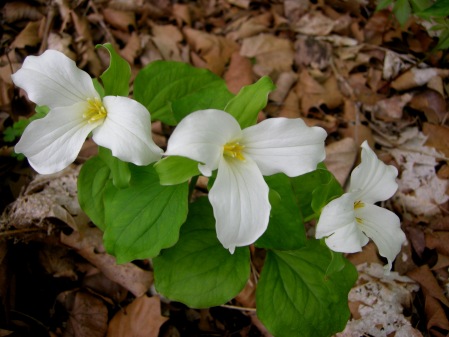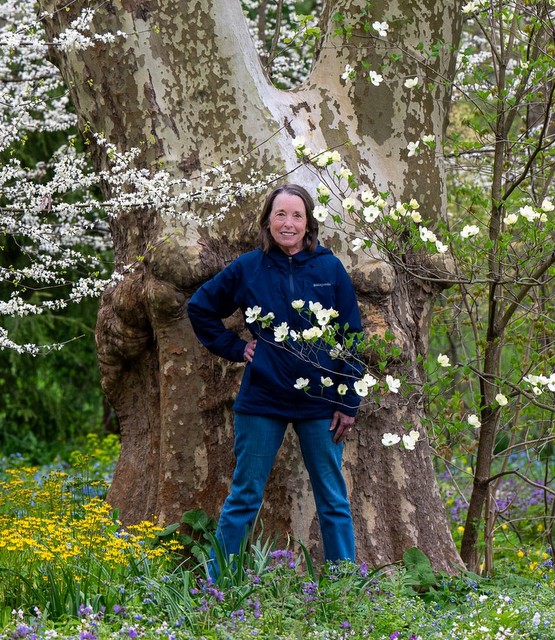 Just a few days ago our woodland was empty, but now it is filled with flowers.
Just a few days ago our woodland was empty, but now it is filled with flowers.
We think that the winter garden at our nursery is gorgeous. But it is still sparse with lots of empty patches of brown leaves even though it is filled with blooming hellebores, snowdrops, cyclamen, winter aconite, and other late winter bulbs. It’s not until early spring that our woodland explodes with color, mostly from native plants taking advantage of all the sunlight before the trees leaf out. I thought you might like to see what that looks like, especially if you visited more than a week ago. Our many epimediums are also in full bloom!
Nursery News: Carolyn’s Shade Gardens is a retail nursery located in Bryn Mawr, PA, specializing in showy, colorful, and unusual plants for shade. The only plants that we ship are snowdrops to US customers only. For catalogues and announcements of events, please send your full name, location, and cell number (for back up use only) to carolyn@carolynsshadegardens.com. Click here to get to the home page of our website for catalogues and information about our nursery and to subscribe to our blog.
 a small field of native Virginia blue bells
a small field of native Virginia blue bells
.
 Epimediums and European wood anemones play a starring role.
Epimediums and European wood anemones play a starring role.
.
 Native cinnamon ferns erupt through the winter aconite.
Native cinnamon ferns erupt through the winter aconite.
.
 Even with all the color below, the three native white-flowered redbuds steal the show.
Even with all the color below, the three native white-flowered redbuds steal the show.
.
 Pine needle paths draw visitors through the woods.
Pine needle paths draw visitors through the woods.
.
 Yellow and blue are my favorite spring colors: here Virginia bluebells with native Celandine poppy and yellow wood anemone.
Yellow and blue are my favorite spring colors: here Virginia bluebells with native Celandine poppy and yellow wood anemone.
.
 Yellow and white is pretty stunning too: here Celandine poppy and white wood anemone.
Yellow and white is pretty stunning too: here Celandine poppy and white wood anemone.
.
 ‘New York Night’ hellebore and native yellow violets
‘New York Night’ hellebore and native yellow violets
And now for the epimediums:
 Red epimedium, E. x rubrum, is a great spreader.
Red epimedium, E. x rubrum, is a great spreader.
.
 Sulphur yellow epimediums, E. pinnatum subsp. colchicum, look great with the blue of pulmonarias.
Sulphur yellow epimediums, E. pinnatum subsp. colchicum, look great with the blue of pulmonarias.
.
 ‘Purple Prince’ epimedium with ‘Pagoda’ dogtooth violets in the background.
‘Purple Prince’ epimedium with ‘Pagoda’ dogtooth violets in the background.
.
.
 The leaves and flowers of ‘Domino’ epimedium are especially lovely, and it flowers twice.
The leaves and flowers of ‘Domino’ epimedium are especially lovely, and it flowers twice.
.
.
 I love orange flowers, and Epimedium x warleyense produces a lot. It’s also a great groundcover.
I love orange flowers, and Epimedium x warleyense produces a lot. It’s also a great groundcover.
.
 ‘Bandit’ epimdium is the perfect size for my miniature hosta rock garden, and its white flowers really stand out against its black-bordered leaves.
‘Bandit’ epimdium is the perfect size for my miniature hosta rock garden, and its white flowers really stand out against its black-bordered leaves.
.
 I love this combination: ‘Tama No Gempi’ epimedium and ‘Little Wonder’ mini hosta.
I love this combination: ‘Tama No Gempi’ epimedium and ‘Little Wonder’ mini hosta.
.
I had to leave so much out—maybe there will be a part two.
Carolyn
Nursery Happenings: You can sign up to receive catalogues and emails about nursery events by sending your full name, location, and cell number (for back up contact use only) to carolyn@carolynsshadegardens.com. Subscribing to my blog does not sign you up to receive this information. Please indicate if you will be shopping at the nursery or are mail order snowdrops only.
Carolyn’s Shade Gardens is a local retail nursery in Bryn Mawr, Pennsylvania, U.S., zone 6b/7a. The only plants that we mail order are snowdrops and only within the US.
Facebook: Carolyn’s Shade Gardens has a Facebook Page where I post single photos, garden tips, and other information that doesn’t fit into a blog post. You can look at my Facebook page here or click the Like button on my right sidebar here.
Notes: Every word that appears in orange on my blog is a link that you can click for more information. If you want to return to my blog’s homepage to access the sidebar information (catalogues, previous articles, etc.) or to subscribe to my blog, just click here.






















